Deliverability
How can marketers help improve email deliverability?

Deliverability

The spam folder is the last place you want your emails to end up. Getting blocked by mailbox providers? Even worse. But how many factors of email marketing deliverability can you truly influence and control?
Deliverability may seem like a complicated mystery. And yes, it gets pretty technical sometimes.
But here’s the reality… The decisions you make as an email marketer could have the biggest, longest-lasting impact on your ability to reach the inbox. Findings from Sinch Mailjet’s original research provide some helpful insights for people handling email customer communications.
We surveyed more than 1,100 email senders for our exclusive report Road to the inbox: Navigating email deliverability in 2025. Here are some of the key findings from the research that relate directly to marketers:
say they are not using a double opt-in method for contact list building (or they’re unsure).
say they rarely or never conduct email list hygiene.
A small percentage believe increasing email engagement is an effective way to improve sender reputation.
say they aren’t using any free tools from mailbox providers to help monitor their email sender reputation.
Building a database of contacts, keeping your email list clean, getting subscribers to engage, and even sender reputation – these are all aspects of email deliverability that marketers influence. And they’re all super important.
Let’s take a closer look at even more findings from the report and what they could mean for your email marketing program.
The first chapter of Road to the inbox asks why email deliverability is so important. More than 78% of respondents said reaching the inbox was vital to their organizations. That finding includes anyone who rated the importance of deliverability an 8 out of 10 or higher. (46% gave it a 10 out of 10.)

So, if reliable deliverability is a priority, whose job is it to make sure emails reach the inbox? Our survey found close to 17% give that job to the marketing team, and another 21% say it’s a combined effort of marketing and IT.
While close to 32% of senders indicated IT oversees deliverability, a combined 38% say marketers bare at least some of the responsibility.
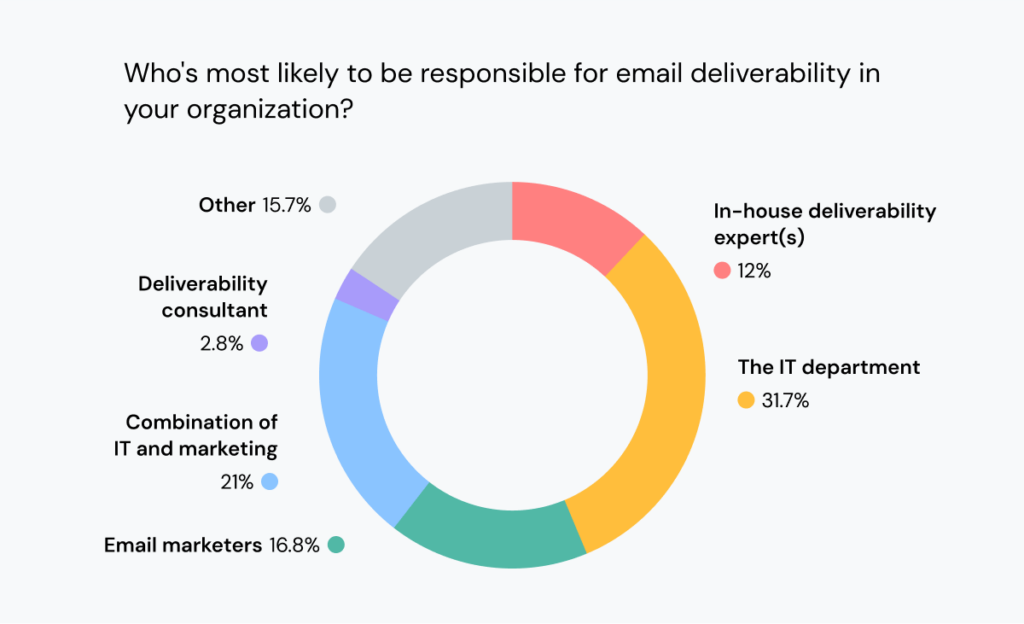
The truth is, there are technical aspects of deliverability that IT needs to handle. That includes everything from email sending infrastructure to email authentication protocols. However, once those things are in place, marketers can often make or break the ability to reach the inbox.
Here’s a diagram showing how email deliverability responsibilities are typically split between IT and marketing. As you can see, there are some areas that both sides need to keep in mind or work on together.
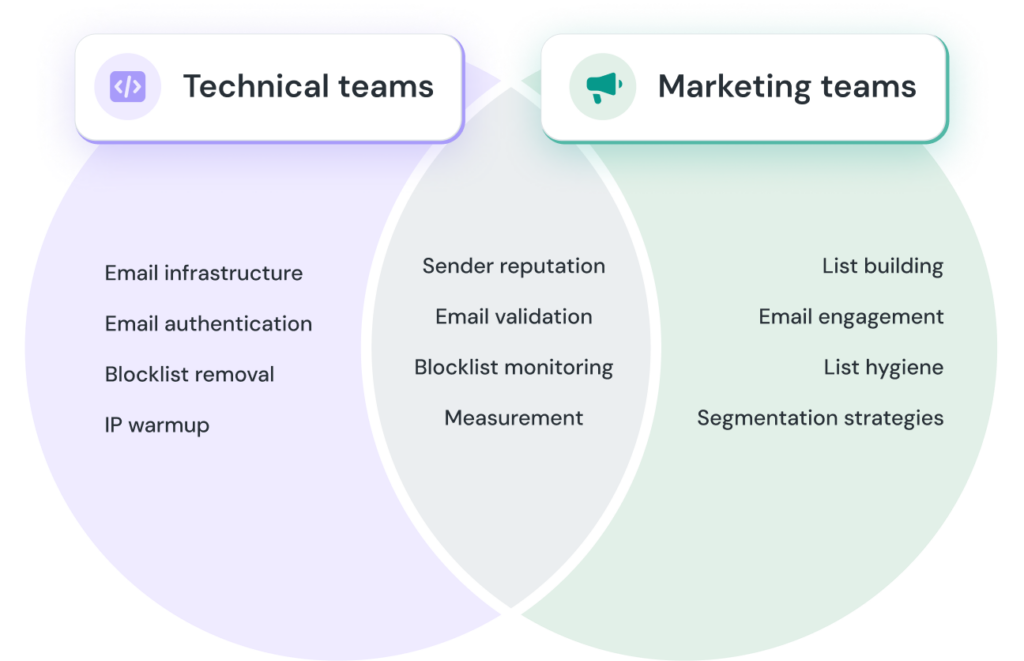
The way contacts do (or do not) engage with your emails has an outsized impact on deliverability. Every email sends signals to mailbox providers, which they use to decide how your messages should be filtered. Some signals are positive, others are negative.
| 👍 Positive engagement signals | 👎 Negative engagement signals |
| High open and click rates | Low open and click rates |
| High read rates | Low click-to-open rate (CTOR) |
| Scroll depth | Deleting emails without reading |
| Replies and forwards | Marking as spam |
| Marking as “not spam” | High unsubscribe requests |
These signals affect your email sender reputation. Put simply – that’s the way mailbox providers like Gmail, Yahoo Mail, and Outlook view you as a sender. They definitely have opinions…
For example, Gmail classifies sender reputations four ways in Google Postmaster Tools:
Only 15% of our survey respondents selected “increasing engagement” as a top way to improve their sender reputation. Yet engagement and inbox placement are directly connected. Because when subscribers engage, that sends positive signals to mailbox providers.
Email engagement and sender reputation go together like peanut butter and jelly. As email deliverability expert Nick Schafer explains, the reason why is simple. Providers such as Gmail, Yahoo, and Outlook want users to have a good experience when those people access their inboxes. Engagement metrics are solid proof that our emails deserve to be in the inbox – not the spam folder.
“Engagement is your lifeline to reputation as a sender. It is extremely important. If you think about what mailbox providers are doing, they want their users to get the emails they want to receive… And the way they do that is by looking at engagement.”

Two other email marketing responsibilities connected to both deliverability and engagement are list building and hygiene.
Since mailbox providers are keeping an eye on engagement, you want contacts on your list who are more likely to stay engaged. That means ensuring new subscribers will continue opening and clicking as you build your list. It also requires ongoing list hygiene to get rid of outdated, unengaged, and invalid email contacts.
Collecting email addresses to add to your list is an excellent way to keep customers and prospects engaged with your brand. If your forms are set up to validate email addresses, it ensures new contacts are legitimate before they’re added to your list.
Another way to verify a new contact’s intent to subscribe is to use a double opt in. This typically involves sending a confirmation email to new subscribers and having them click on a link before other messages start arriving.
While around 40% of senders in our survey say they use a double opt in, that leaves 60% who do not or are unsure if that’s an email best practice they follow. Nick Schafer says he highly recommends all senders use a double opt in for every email program.
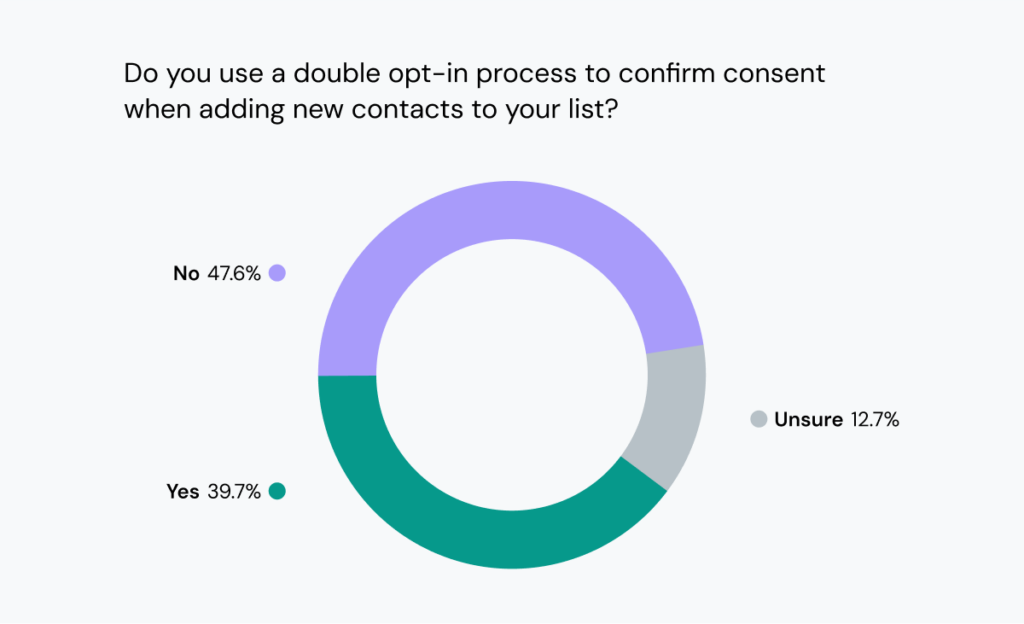
Our Road to the inbox report also found around 1 in 10 senders has either bought a list or scraped the web to collect new contacts in the last two years. This is a bad idea. You could be breaking privacy laws by sending to these contacts.
Plus, they’re less likely to engage and more likely to mark your emails as spam. Why? Because you are spamming them if they never subscribed.
An added benefit of using a double opt in is that you confirm their consent to subscribe. This provides a record that shows you’re complying with consumer privacy laws like the GDPR and CCPA.
Just over 60% of senders we surveyed claim to conduct list hygiene on a regular basis. In fact, 27% clean up their email contacts at least once a month. Unfortunately, close to 40% say they rarely or never conduct list hygiene.
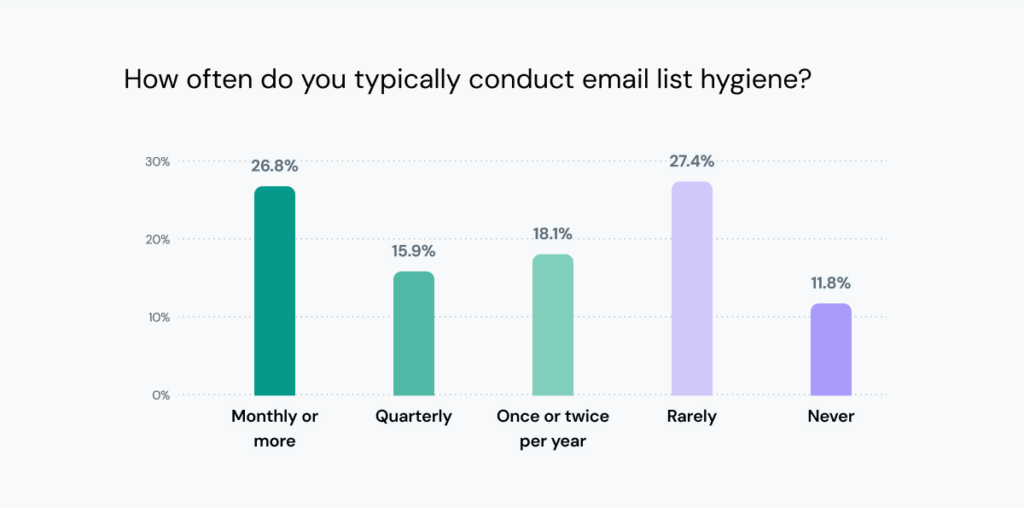
Failing to keep an email list clean will eventually lead to deliverability problems. Your database degrades in quality over time. People abandon email addresses or simply stop caring about what you’re sending. To mailbox providers, this looks like you’re being irresponsible and sending unwanted emails.
One way to manage your email list and optimize for higher engagement rates is to implement a sunset policy. This process involves setting a threshold for segmenting or removing unengaged subscribers. When people don’t open emails after 90 days or 6 months, for example, you can strategically email them less often or proactively unsubscribe them from your list.
Our research found less than a quarter of senders (24%) have a sunset policy in place. While it might be difficult and feel strange to email certain people less often or even delete contacts from your database, sunset policies are a very effective way to conduct regular list hygiene.
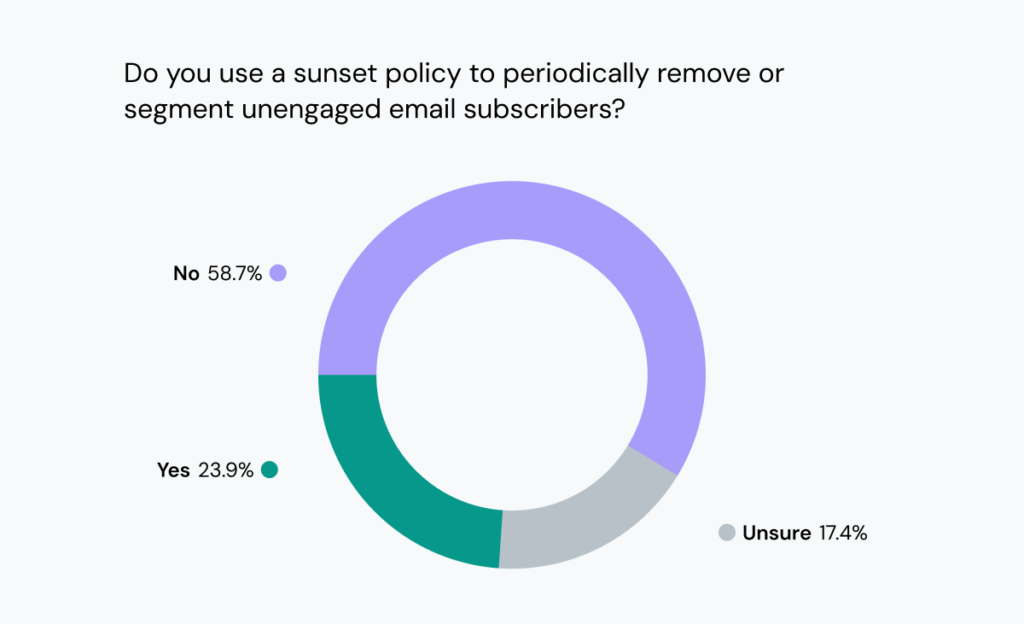
If you’re in charge of email marketing, it’s very likely you’re also in charge of growing and managing the list. Keeping it up-to-date, clean, and using ethical list building practices protects your sender reputation and improves your chances of landing in the inbox.
We’re not saying understanding email deliverability is always easy. There’s a reason Sinch Mailjet has an entire team of technical account managers (TAMs) who help their clients optimize sending for inbox placement.
However, there are many ways to maximize your opportunities to improve email deliverability, even if your company doesn’t have a consultant or in-house expert.
Major mailbox providers aren’t out to ruin your day and filter your messages to the junk folder. They simply have their users’ best interests in mind. That’s why Google, Microsoft, and Yahoo offer free tools and dashboards to help you understand your sender reputation and what can be improved:
Unfortunately, our research found very few respondents are taking advantage of these services. Nearly 70% of them don’t use these tools at all. Google Postmaster Tools was the most popular reputation monitoring service, but only 28% of respondents are using it.
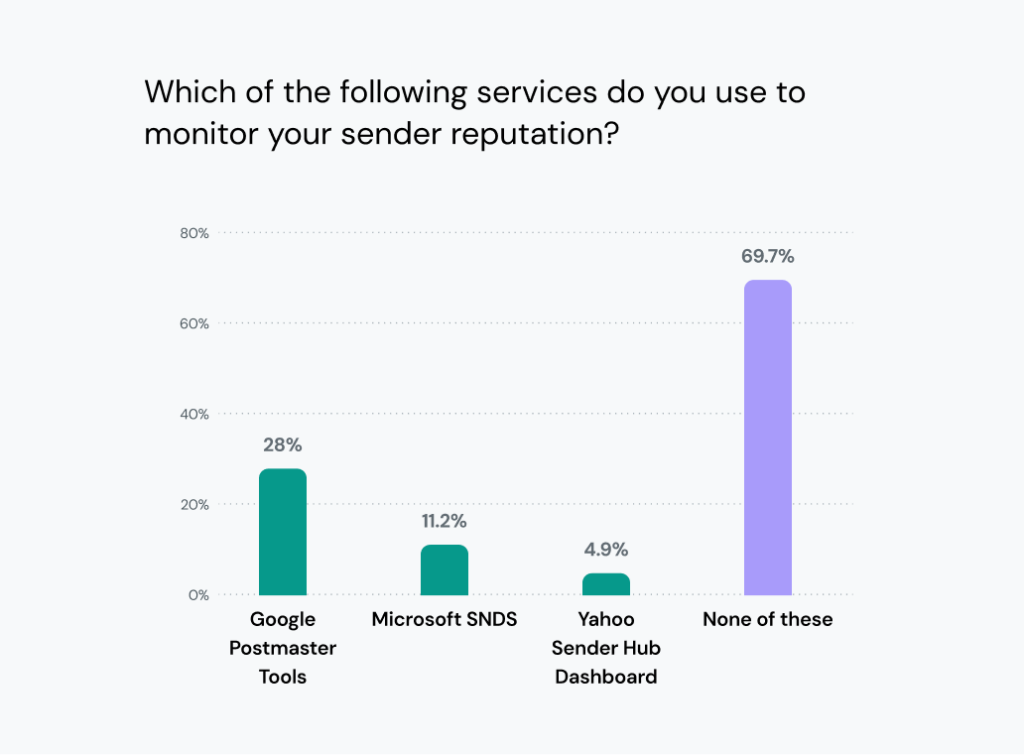
Check out the chapter on engagement and reputation to find out more about how to use Google Postmaster Tools and what you can learn from the service as an email marketer.
“Mailbox providers like Gmail want you to do the right thing. They want senders to have all the information they can. The fact that so few organizations are using Google Postmaster Tools is sad. If you’re not checking all the information that’s available to you, then you’re missing out.”

Are you still blasting out the same email campaign to every contact on your list? We can practically guarantee this is doing more harm than good. It’s time to take the next step and use some more advanced email marketing tactics.
Segmentation and personalization, for example, are two effective ways to make your emails relevant and interesting. Campaigns that are more meaningful are always more engaging.
Email A/B testing is the best way to understand what your contacts find most engaging. Need help coming up with ideas to test? Leading ESPs, including Sinch Mailjet, now offer AI assistants to help you brainstorm and generate everything from subject lines to templates.
High converting sign-up forms and landing pages let you build an email list of subscribers who are ready to opt in and start engaging. Plus, email automation lets you connect with contacts at key touchpoints and build marketing workflows that help you reach people exactly when they need to hear from you.
We designed the Sinch Mailjet platform to provide all the tools you need to launch an engaging and effective email marketing program. Use them right and you’ll vastly improve your chances of reaching the inbox.
Email deliverability puts a lot of focus on making it to the inbox. It’s easy to forget that what happens after those emails reach their destination affects the deliverability of future campaigns.
People won’t engage if it’s difficult to do so. That means you need to be sure your emails are easy to view, read, and interact with inside of every inbox.
In the last chapter of Road to the inbox, we explore the importance of optimizing emails for every recipient. That includes creating mobile responsive emails, thinking about dark mode emails, ensuring campaigns render properly on different email clients, and considering email accessibility.
All of those factors are also up to email marketers to address and improve. Here at Sinch Mailjet, we continue to build our platform to help senders get the most out of the email channel. Keep in touch and sign up for free today so you can be among the first to take advantage of what’s next.